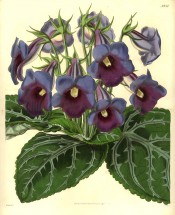History of the Florists’ Gloxinia
A brief history of the florists’ Gloxinia, courtesy of the Floricultural Cabinet. The author is anonymous but is probably Joseph Harrison, the conductor of the magazine.
‘The species which first bore the name was G. maculata, having been discovered in South America, and introduced into England in 1739. It is therefore almost one of the oldest of our hothouse plants, for but a few years prior to its introduction the first glass plant-house in England was constructed. It is, too, one of the handsomest blooming hothouse plants we possess even at the present day, when properly treated. Its native situation, in South America, is on the margin of dense woods, where the surface soil is a light leafy mould; and it is worth a remark here, that all the species subsequently discovered in South America and introduced into England were found growing in similar leaf-mould and situation.
The next species introduced was G. speciosa, in 1815, being seventy-six years after the introduction of G. maculata; G. caulescens, in 1820; G. hirsuta, in 1824; and subsequently, G. digitaliflora, G. tubiflora, G. discolor, and G. picta, as well as some others more recently. The accession of so many diversified and handsome species soon presented scope for the attempt to raise hybrids, and the result has been especially successful, in the production of many highly beautiful, and very distinct both in form and colours. In 1845, the most singular and distinct was raised from seed saved the year previous, by Mr. John Fyfe, gardener, at Rothesay, Buteshire, in Scotland. It is supposed the seed was obtained from G. maxima, but what its blossoms had been impregnated by, it appears, is not known. The form of the flower and its erect position very much resemble the lovely blue Spring-gentian. It bloomed first in 1845, and attracted universal attention and admiration at the principal exhibitions throughout the country, differing so widely from every other Gloxinia then existing, and the flowers being so strikingly beautiful.
Since the G. Fyfiana was raised, much attention has been paid by nurserymen and others, both in our own country and on the continent, to produce improved varieties of the general class of Gloxinias, and the result has been crowned with great success; we now have upwards of sixty kinds, very distinct and beautiful. Four years ago Mr. Haage, jun., nurseryman of Erfurt, succeeded in obtaining a number of very handsome hybrids from the impregnation of G. Fyfiana, giving us a most valuable acquisition to the erect-flowering section. The three we figure in our present plate are selected from the collection.’ [FC p.97/1855].
Most if not all of the Gloxinias grown by Macarthur are cultivars of Sinningia speciosa, the florists’ gloxinia, a popular greenhouse plant in England in the Victorian era, directly descended from the earliest cultivars, such as G. fyfiana. By 1853 the Floricultural Cabinet was able to report ‘there now being 140 kinds in cultivation’, in excess even of the ‘upwards of sixty kinds’ reported in the same magazine two years later. This journal had previously provided very sound advice on the management and culture of gloxinias, as pertinent to the modern florist as when it was written.
On the cultivation of Gloxinia speciosa, G. caulescens, and G. maculata
‘The Gloxinias are plants that possess considerable beauty, and are particularly deserving of cultivation. The following is my practice:- some time during the summer, I take a quantity of leaves from each sort I wish to propagate, cutting them close off at the surface from the parent plant. I then prepare a quantity of pots, sixties, with a compost of loam, leaf mould, and peat soil in equal parts, adding as much fine sand as will keep it perfectly open. I then insert a cutting (a leaf) in each pot, half an inch deep, pressing the soil pretty firm. After the whole is finished, I give a gentle watering with a fine syringe, and place them in a hot-bed frame, if I have one at work, or a stove, which is nearly as well. Water must now be given with great caution, for too much moisture would cause them to rot. I let them remain in the same pots, after the bulb is formed, until the period arrives for rest, which is easily known by the leaf gradually dying away. I then remove them to a dry cool place, taking care that they do not get much moisture during the winter. In the latter end of February, or beginning of March, I take all the pots of roots, and carefully shake all the mould from them, and then pot the largest in forty eights, and the small ones into sixty sized pots, taking care that they are well drained with broken potsherds. After the whole are potted, I give only sufficient water to settle the earth to the roots, and then place them in a warm part of the stove. As the plants advance in growth, and fill the pots with roots, I again remove them out of sixties into forty-eights, and those out of forty-eights into thirty-twos. Two or three times during the summer months, I find it very beneficial to water them with liquid manure. As soon as they begin to flower, I place them in the greenhouse amongst the plants, where they bloom profusely, and look very splendid. Nothing more is required but occasionally supplying with water. [Mr. W. Mountford in FC p.57/1834].


